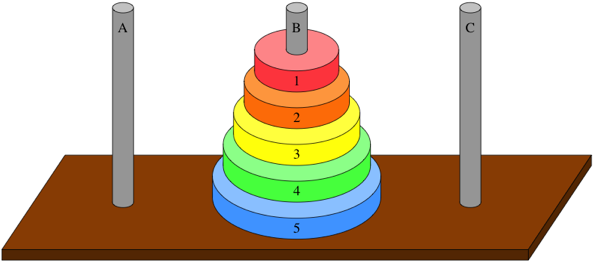Hanoi Tower
You are given a set of three pegs and n disks, with each disk a different size. Let's name the pegs A, B, and C, and let's number the disks from 1, the smallest disk, to n, the largest disk. At the outset, all n disks are on peg A, in order of decreasing size from bottom to top, so that disk n is on the bottom and disk 1 is on the top. Here's what the Towers of Hanoi looks like for n = 5 disks:

The goal is to move all n disks from peg A to peg B:

Analysis:
While, this is a representative recursive problem.
To move n disks from peg A to peg B.
1.We can move the top n-1 disks from peg A to peg C first.
2.Then move the bottom one from A to B. Then move all the n-1 disks from peg C to peg B.
Solution:
public class HanoiTower(){
class Tower{
private Stack<Integer> disks;
private int index;
public Tower(int i){
disks=new Stack<Integer>();
index=i;
}
public int index(){
return index;
}
public void add(int d){
if(!disks.isEmpty() && disks.peek() <=d) System.out.println("Error placing disk"+d);
else disks.push(d);
}
public void moveTopto(Tower t){
int top=disks.pop();
t.add(top);
System.out.println("Move disk"+ top + "from"+index() + "to"+ t.index());
}
public void print(){
System.out.println("Contents of Tower" + index());
for(int i=disks.size()-1;i>=0;i--)
System.out.println(" "+disks.get(i));
}
public void moveDisks(int n, Tower destination, Tower buffer){
if(n>0){
moveDisks(n-1, buffer, destination);
moveTopto(destination);
buffer.moveDisks(n-1, destination, this);
}
}
}
public static void main(String[] args){
int n=N;
Tower[] tower=new Tower[3];
for(int i=0;i<3;i++) tower[i]=new Tower(i);
for(int i=n-1;i>=0;i--) tower[0].add(i);
tower[0].moveDisks(n, tower[2],tower[1]);
}
}